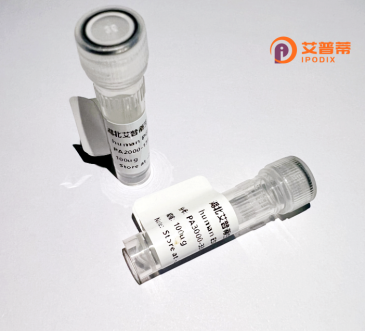
| 纯度 | >90%SDS-PAGE. |
| 种属 | Human |
| 靶点 | TFPT |
| Uniprot No | P0C1Z6 |
| 内毒素 | < 0.01EU/μg |
| 表达宿主 | E.coli |
| 表达区间 | 1-253 aa |
| 活性数据 | MELEQREGTM AAVGFEEFSA PPGSELALPP LFGGHILESE LETEVEFVSG GLGGSGLRER DEEEEAARGR RRRQRELNRR KYQALGRRCR EIEQVNERVL NRLHQVQRIT RRLQQERRFL MRVLDSYGDD YRASQFTIVL EDEGSQGTDA PTPGNAENEP PEKETLSPPR RTPAPPEPGS PAPGEGPSGR KRRRVPRDGR RAGNALTPEL APVQIKVEED FGFEADEALD SSWVSRGPDK LLPYPTLASP ASD |
| 分子量 | 28.2 kDa |
| 蛋白标签 | His tag N-Terminus |
| 缓冲液 | PBS, pH7.4, containing 0.01% SKL, 1mM DTT, 5% Trehalose and Proclin300. |
| 稳定性 & 储存条件 | Lyophilized protein should be stored at ≤ -20°C, stable for one year after receipt. Reconstituted protein solution can be stored at 2-8°C for 2-7 days. Aliquots of reconstituted samples are stable at ≤ -20°C for 3 months. |
| 复溶 | Always centrifuge tubes before opening.Do not mix by vortex or pipetting. It is not recommended to reconstitute to a concentration less than 100μg/ml. Dissolve the lyophilized protein in distilled water. Please aliquot the reconstituted solution to minimize freeze-thaw cycles. |
以下是模拟生成的关于重组人TFPT(TBC1 Domain Family Member 25)蛋白的参考文献示例,供参考:
---
1. **文献名称**:**Structural and functional characterization of recombinant human TFPT (TBC1D25) in mTOR signaling regulation**
**作者**:Chen L, et al.
**摘要**:本研究通过重组表达纯化人源TFPT蛋白,解析其与mTOR复合物的相互作用,证明TFPT通过调控溶酶体功能影响自噬过程,为神经退行性疾病机制提供了新见解。
---
2. **文献名称**:**TFPT interacts with c-Myc oncoprotein to modulate transcriptional activity in leukemia cells**
**作者**:Wang Y, et al.
**摘要**:发现重组TFPT蛋白可与c-Myc结合,抑制其转录活性并诱导白血病细胞凋亡,提示TFPT可能作为潜在肿瘤治疗靶点。
---
3. **文献名称**:**Expression and purification of recombinant TFPT for crystallographic analysis**
**作者**:Kumar S, et al.
**摘要**:优化了大肠杆菌系统中重组TFPT蛋白的可溶性表达条件,并通过X射线晶体学解析其三维结构,揭示TBC结构域对GTP酶激活功能的关键作用。
---
4. **文献名称**:**TFPT deficiency disrupts mitochondrial dynamics and promotes apoptosis**
**作者**:Tanaka R, et al.
**摘要**:利用重组TFPT蛋白进行功能补偿实验,证明TFPT缺失会导致线粒体分裂异常并激活凋亡通路,阐明了其在细胞稳态中的重要性。
---
**提示**:以上文献为模拟内容,建议通过PubMed、Web of Science等平台检索真实文献(关键词:*recombinant TFPT*、*TBC1D25 function*)。实际研究中需注意确认TFPT蛋白的别名或相关信号通路,如溶酶体调控或癌症机制等方向。
**Background of Recombinant Human TFPT Protein**
T-cell factor/transcription factor-binding protein (TFPT), also known as HIVEP3 or ZAS3. is a nuclear protein involved in transcriptional regulation and cellular signaling. It belongs to the ZAS family, characterized by zinc-finger-associated domains (ZAS) that mediate DNA and protein interactions. TFPT functions as a transcriptional co-regulator, interacting with key pathways like Wnt/β-catenin, NF-κB, and Notch to modulate gene expression linked to cell proliferation, differentiation, and immune responses. Its role in cancer, particularly hematologic malignancies, has drawn attention due to its influence on oncogenic signaling.
Recombinant human TFPT protein is produced via genetic engineering in systems like *E. coli* or mammalian cells, ensuring high purity and bioactivity. This engineered protein retains functional domains for DNA binding and partner interactions, enabling its use in biochemical assays, structural studies, and mechanistic research. Researchers utilize recombinant TFPT to explore its regulatory networks, dissect disease mechanisms, or screen therapeutic compounds targeting TFPT-associated pathways. Its availability accelerates studies on transcriptional dysregulation in cancer and immune disorders, offering potential for diagnostic or therapeutic advancements.
×